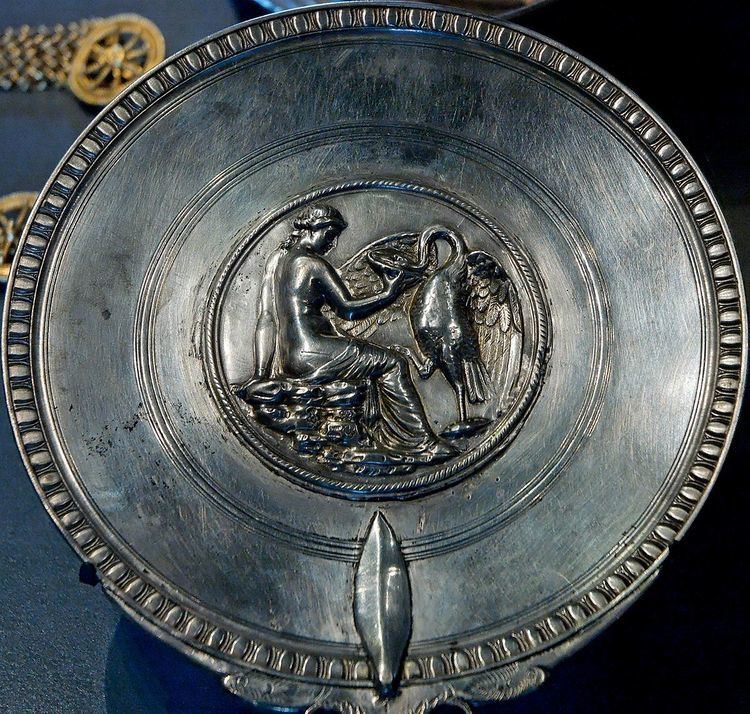Material Silver | ||
 | ||
Created 1st Century AD (mostly) Present location | ||
The Boscoreale Treasure is the name for a large collection of exquisite silver and gold Roman objects discovered in the ruins of an ancient villa at Boscoreale, near Pompeii, southern Italy. Consisting of over a hundred pieces of silverware, as well as gold coins and jewellery, it is now mostly kept at the Louvre Museum in Paris, although parts of the treasure can also be found at the British Museum.
Contents
History
Located northwest of Pompeii, Boscoreale was the location of a large Roman villa, the Villa della Pisanella, that was buried by volcanic ash following the eruption of Mount Vesuvius in 79 AD. The villa was unearthed during several archaeological seasons, confirming the hypothesis of a villa rustica covering 1000 square metres with clearly defined residential sector and farm buildings. The villa was discovered in 1876, but it was only on April 13 1895 that the remains of a vaulted box containing the treasure was discovered in the wine-pressing room of the villa. The box contained silver tableware consisting of 102 items and a leather bag full of coins to the value of a thousand gold aurei. Many items of precious metal were abandoned in Pompeii and its surrounding area by their owners as they attempted to flee the destruction.
Most of the Boscoreale Treasure was illicitly trafficked out of Italy and was later purchased by Baron Edmond de Rothschild. who donated it to the Louvre Museum in 1896. Baron de Rothschild (19 August 1845 – 2 November 1934) was a French member of the Rothschild banking family. Given the number of the items, their weight over 30 kg, their technical quality and aesthetic value, the silver set from Boscoreale is among the most important and most prestigious sets of this period.
It is assumed that the objects were intentionally hidden in the storehouse before the eruption of Mt. Vesuvius in AD 79. The last owner of the silver set was probably a woman named Maxima – a name written on many of the vessels. A woman was found nearby but there is no definitive answer to the question of whether she is Maxima. It is assumed that the owner of the villa and the entire property is L. Caecilius lucundus, a banker from Pompeii, who inherited the wealth of the Julio-Claudian dynasty in Campania, and that he was the father of Maxima.
Description
The treasure consists of 109 pieces of silverware, as well as gold jewellery (necklaces, bracelets and earrings) and over 1000 gold coins. Items from the hoard vary in date from 4th Century BC to 1st Century AD. Many of the silver items from the treasure are considered masterpieces of Roman art that could only have belonged to the very elite sections of society. A few objects also seem to be family heirlooms passed down the generations. Parts of the hoard are inscribed with the name Maxima who were perhaps the original owner. Some of the most well-known items in the treasure include:
Roman Gold Aurei
No formal study of the coins was made before they were dispersed into the market and, as is often the case, it is very possible that a list published in 1909 includes material from other finds.
The most recent coin of the Boscoreale hoard dates to AD 79, the date of the eruption. The intense heat from Mount Vesuvius imbued all the gold coins with the beautiful red toning that we now see.
